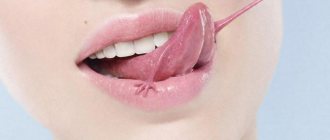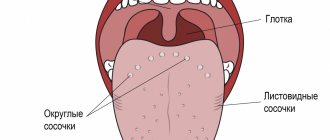- Why do you need to clean your tongue?
- How to clean your tongue
- How to clean your tongue
For many people, oral hygiene ends with brushing their teeth. However, cleaning your tongue is also necessary and important. Plaque and bacteria accumulate on it, from which caries develops and an unpleasant odor appears.
Regular tongue cleaning helps to avoid diseases such as stomatitis, gingivitis, caries and even periodontitis. Now we will look in detail at why you should clean your tongue and how to do it correctly and effectively.
Why do you need to clean your tongue?
Brushing your tongue twice a day not only cleanses it of bacteria. This cleaning eliminates four problems.
- Prevents the development of caries
by preventing microorganisms from producing acid that destroys enamel. - Removes bad breath
because bacteria do not produce odorous substances. - Removes plaque
- a breeding ground for bacteria. - Increases the sensitivity
of taste buds - a clean tongue senses the flavors of food and drinks more clearly.
When caring for your tongue, it is worth remembering that not every coating is a sign of some problems. There is also a healthy plaque that can be easily removed with proper hygiene.
Healthy plaque
can be easily distinguished by several signs.
- It is formed
in the morning, after eating or during thirst; - disappears
after cleansing; - changes color
due to coloring by products; - through it you can see
the surface of the tongue; - it doesn't smell
.
Unhealthy plaque can be a symptom of many health problems: diseases of the stomach and intestines, dysfunction of the liver and kidneys, infections in the body (whooping cough, foot and mouth disease, scarlet fever, pityriasis rosea), as well as a consequence of taking antibiotics.
This is what characterizes an unhealthy plaque
.
- It remains
even after thorough cleaning; - It smells
bad ; - very dense and quickly restored
after cleaning; - regardless of food, the color ranges
from yellow to brown; - accompanied by
redness, swelling and cracks of the tongue, nausea, bitterness in the mouth, gastrointestinal upset, etc.
If the plaque is deep yellow or gray-yellow, you should pay attention to the gastrointestinal tract - you may have gastritis, ulcers, pancreatitis. And if frequent and severe heartburn occurs, the plaque will turn yellow-orange.
But we must remember that harmful plaque is not always caused by some disease. It can appear due to an unhealthy lifestyle: smoking, a large amount of dyes in foods, poor hygiene, even due to caries and bleeding gums. Brushing your tongue with a toothbrush will not solve this problem - you need to contact a specialist to understand how to proceed.
Dental clinic No. 2
If you are in good health, have healthy teeth and gums, and take care of your oral hygiene, the most likely cause of bad breath is a bacterial coating on the back of your tongue.
The following procedure can be done once a day, preferably in the morning, however, if done in the evening, it will not only improve your morning breath, but will also make your bed partner much happier.
The first step in treating odor caused by bacterial coating on the tongue is simply to vigorously remove the plaque using a tongue scraper or an inverted spoon. In reality, you not only remove the mucous layer, but also give your tongue a haircut. It is necessary to scrape the upper surface of the tongue very carefully, trying to get as deep as possible, since the filiform papillae are located on a very distant part of the back of the tongue. If you run your finger across your tongue towards the throat, you will feel the grooved papillae of the tongue, which form a “V” shaped line on the back of the tongue. It is important to clean the surface of the tongue almost to these tubercles. The grooved papillae of the tongue themselves cannot be rubbed off. It is normal to feel a gag reflex during the tongue cleaning process, however, consistency pays off and this sensation will subside over time as you get used to it. The gag reflex is largely psychological and you will learn to overcome it. Remember, scrubbing should be vigorous enough, but not so vigorous that it causes pain and bleeding. Once you see what you've scraped off your tongue, you'll understand the potential for bad breath that lies within the papillae of your tongue.
Once you have cleaned your tongue, the second step in eliminating bad odor is to remove the VSCs and anaerobic bacteria that remain after cleaning. This can be easily achieved by gargling or treating the tongue with a 1.5 percent solution of hydrogen peroxide (available at any pharmacy). Hydrogen peroxide releases oxygen. This is why the solution bubbles when it comes into contact with bacteria or blood. The hydrogen peroxide you buy at the store is a 3 percent solution. Therefore, you need to dilute peroxide half and half with water to gargle, but you can use 3% hydrogen peroxide when cleaning your tongue. Vigorous scrubbing with hydrogen peroxide will help remove the bacterial layer while oxidizing the treated area.
The use of hydrogen peroxide leads to two simultaneous effects:
- The oxygen released by hydrogen peroxide reacts with VSCs, thus neutralizing them and effectively removing the chemicals directly responsible for bad breath.
- The oxygen released by hydrogen peroxide kills the anaerobic bacteria responsible for the production of VSCs. Hydrogen peroxide is cheap and very effective at neutralizing VSCs and removing anaerobic bacteria, but does not taste good, so you can use mouth rinses containing similar formulations to remove the cause of bad breath.
How to clean your tongue
Do not use regular toothbrushes for cleaning - they will not be able to remove plaque. It is better to pay attention to special tongue cleaning products.
Scrapers
The most common devices are scrapers. The tips of the scrapers are made in the shape of a spoon. They are usually made of plastic, sometimes with stiff bristles. The flat shape prevents the gag reflex that may occur when brushing the root of the tongue. This scraper needs to be changed every six months.
Irrigator attachments
Tongue attachments are also made in the form of a spoon. The irrigator, unlike a conventional scraper, delivers a stream of water, which additionally washes the surface of the tongue.
Attachments for electric brushes
Most brush manufacturers offer special attachments for their products to clean tongue deposits. As a rule, they have a flat, textured rubber surface.
Tongue gels
You should not clean your tongue with toothpaste - it is intended for teeth. Pastes contain abrasives and menthol, they can irritate the mucous membrane. Special gels that gently dissolve plaque and also disinfect the oral cavity are better suited for the tongue.
How to rinse your nose?
To alleviate the condition, it is necessary to clean the nasal cavity. This is rinsing the nasal cavity with an isotonic solution. It can be prepared at home.
“For a liter of warm boiled water, a teaspoon of table salt.”
For rinsing at home, you can use a 20 gram syringe. The most important thing is that when we introduce liquid into the nasal cavity while blowing your nose as you exhale, do not cover the blowing side of the nasal cavity. That is, do not increase the pressure in the nasal cavity.
When you blow your nose incorrectly, there is a high chance of infection getting through the auditory tube into the middle ear area and otitis media occurs.
Through the anastomosis from the nasal cavity, an infection can enter the paranasal sinuses and sinusitis occurs - this is, first of all, sinusitis and frontal sinusitis.
How to clean your tongue
If you don't have any health problems that affect the plaque, just follow these guidelines and remember to brush until all the plaque is removed and your tongue is pink again. Typically, tongue hygiene takes only 20–30 seconds.
Recommendations for adults
- Proceed with the procedure only after brushing your teeth
and rinsing your mouth. - Use special tools
: scrapers, nozzles and others. - Clean your tongue using sweeping movements
and light pressure. - Start from the root of the tongue
and end with the tip. - Do not brush your tongue with cross movements and do not press
too hard - this can damage it. - Don't forget to clean the instrument
after the procedure. - Be sure to rinse your mouth
with water.
Should children have their tongues cleaned?
Children also need tongue care, but not earlier than 3–4 years.
For younger children, tongue cleaning is pointless. They don’t eat junk food, especially not in the same quantities as adults, and they don’t drink tea and coffee. Until 3–4 years of age, normal oral care is sufficient. From 3–4 to 8 years
This is how you should clean your tongue.
- Move from the root of the tongue to the tip
with smooth sweeping movements, with even weaker pressure than with adults. - Similarly, clean the sides
of the tongue and the inside of the cheeks. - Be sure to rinse your mouth
.
From the age of 8
you can already use scrapers.
Independent ear toilet
As noted above, ears do not require special cleaning. According to the American Academy of Otolaryngology, wax removal should only be done when plugs form and unpleasant symptoms occur.
Sulfur removal sequence:
- Drops to soften sulfur or a solution of hydrogen peroxide (3%) are taken into a warm pipette.
- Lie on your side and carefully pour/drip the solution into your ear.
- Leave for 5-7 minutes.
- Press a napkin to your ear and tilt your head.
- Use a small bulb to rinse the ear canal with warm water (~37°C), pulling the earlobe up and out.
- Blot the ear with a napkin to remove any remaining water.
The procedure can only be performed on a healthy ear, and very carefully. Perforation of the eardrum and inflammation are contraindications for getting rid of wax on your own. A doctor will help identify the pathology: depending on the symptoms, he will conduct an additional examination.
To avoid injury or other complications, it is best to carry out cleaning in a medical facility. At the clinic, the otolaryngologist will perform irrigation - washing the ear canal with a stream of water under pressure. Doctors use a special syringe or electronic irrigator with pressure control, directing the stream at different angles. In the case of dense wax, the doctor will examine the ear canal using a mirror to ensure that the ear is completely clean. If irrigation is contraindicated, the ENT doctor removes the sulfur plug using special instruments (probe, otoscope and others).
For detailed advice on the procedure, please contact otolaryngologists at the President-Med medical centers
What else can you use to rinse your nose?
In no case - only an isotonic solution. Everything that we add additionally, either garlic juice or some herbal decoctions, are allergens of plant origin. And we can cause or provoke an allergic reaction.
Another thing is some kind of antiseptics, then yes. Antiseptics that can be added to the rinsing solution - for example, elemental Chlorhexidine or Miramistin. These drugs can even be diluted one to one.
But this is when we talk about bacterial rhinitis. And in our case, acute viral rhinitis occurs against the background of ARVI. But then, in the event of some unfavorable factors, let’s say a decrease in immune status, some kind of air pollution, a secondary bacterial infection very often occurs. And gradually viral rhinitis (viral infection) is replaced by a bacterial form.
Filmed specifically for the educational project “Dispensary” profilaktorium.ru
Why do you need to clean your tongue?
The benefits of tongue cleaning will be noticeable if the procedure is carried out regularly and correctly. Such care is especially important if there is a thick, dense coating of yellow, gray or brown color that has an unpleasant odor. These signs may indicate:
- infectious diseases - sore throat;
- fungal infections of the oral mucosa - candidiasis;
- pathologies of the digestive system;
- disorders of intestinal microflora;
- helminthic infestations;
- long-term use of certain medications;
- unbalanced diet;
- insufficient oral care.
Cleaning not only provides a fresh smell, but also gets rid of many pathogens. Its regular implementation allows you to get rid of tartar and other dental diseases. The procedure stimulates the functioning of internal organs and helps to better perceive the taste of food dishes.










